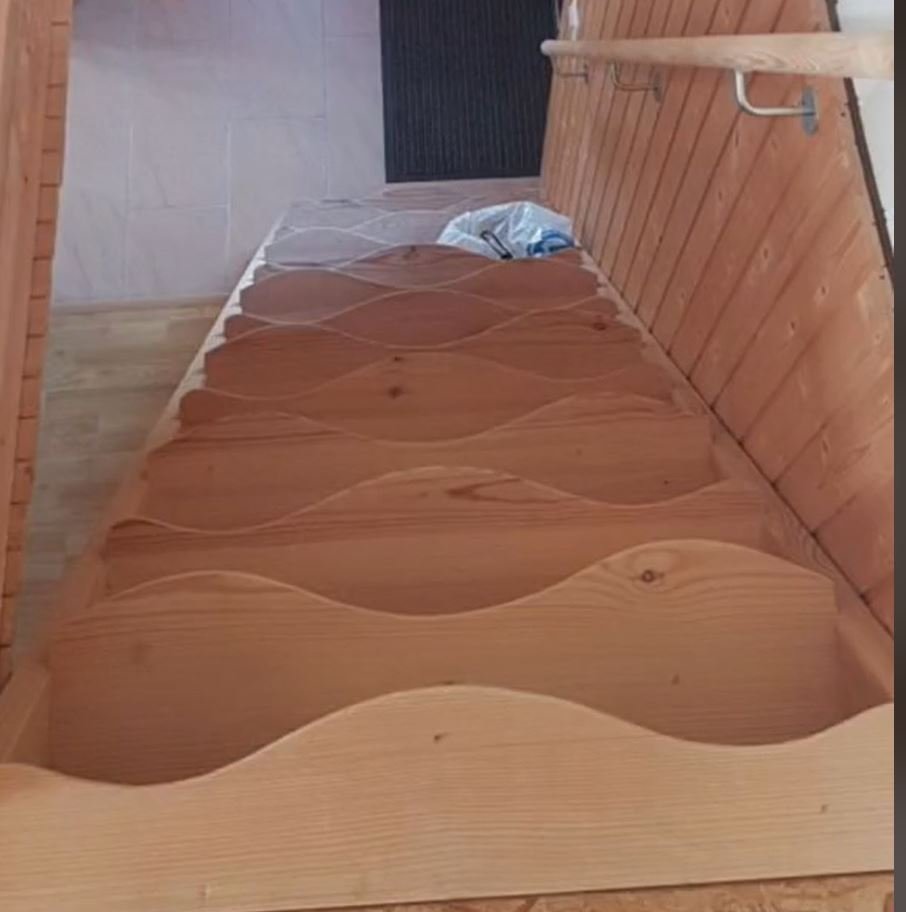Witches’ stairs are a strange but interesting design feature that became popular on TikTok a couple of years ago. Even though they have an unusual history, their name doesn’t really have to do with superstition. Instead, these stairs are a clever design choice. When made and installed correctly, they can be both useful and nice to look at!
Witches’ Stairs aren’t what they Appear.

While the stories about witches’ stairs might sound more interesting, they actually have a very practical purpose. They are really useful in homes with little space, like attics, lofts, and tiny houses. Witches’ stairs are designed to save space while still allowing you to go from one floor to another. Architects often call them “alternate tread stairs.”
How Witches’ Stairs Function

Photo Credit: itsthatrealestatechick | TikTok
Witches’ stairs are designed to save space in two ways. First, each step is only half as wide as regular steps, and the steps are staggered. This makes the staircase narrower than a traditional one. These smaller stairs can also be used for extra storage, like for books or displaying items. According to Scott Schuttner, who wrote “Basic Stairbuilding,” the distance between the steps on one side of an alternating-tread stair is twice the height of the rise, which gives you more space on the steps and makes them safer.
Besides being practical, witches’ stairs meet building codes and safety standards in the U.S. A standard staircase is usually 3 feet wide, while a residential witches’ staircase is typically between 27 and 30 inches wide.
Real Origins

Photo Credit: itsthatrealestatechick | TikTok
In 1985, a businessman named J.M. Lapeyre created a metal version of witches’ stairs. He thought these stairs could be a safe alternative to ladders in commercial and warehouse settings, especially in tight spaces where ladders might not be safe. This design is also used on commercial ships and oil rigs, and it can be called ship stairs or ship ladders, in addition to witches’ stairs and alternate tread stairs.
Misconception

Photo Credit: itsthatrealestatechick | TikTok
When videos of witches’ stairs first appeared on TikTok in 2021, they were linked to an urban legend. According to this legend, these staircases were built in 17th-century Massachusetts to keep witches away during the Salem witch trials because “witches can’t climb up them.” This idea has been proven false, but another rumor suggests that Thomas Jefferson came up with the design. Because of this, witches’ stairs are sometimes called Jeffersonian or Jefferson stairs. However, an original version of the design was also mentioned in a book called “Monckton’s One Plane Method Of Hand Railing and Stair Building,” published in 1888.
Debunking the Myth

Photo Credit: conspiracy___time | TikTok
The exact origins of witches’ stairs are a bit unclear, but one thing is clear: there’s no historical evidence that they were designed to keep witches away. Historian Robin Briggs has studied many historical sources and found no mention of stairs that could disable witches. Interestingly, some people with these unique staircases also buried “witch bottles” or included dead cats in their homes for protection against witchcraft, but Briggs calls this idea “pure disinformation.” He notes that the closest belief was that putting a broom over the door would trap a witch inside.
While it’s fun to think about myths and legends, it’s also interesting to know the real history of witches’ stairs. Regardless, they offer a unique and decorative alternative to regular staircases, adding a fun and quirky touch to home design.
We Adopted a 4-Year-Old Girl – A Month Later, She Came to Me and Said, ‘Mommy, Don’t Trust Daddy’

A month after adopting Jennifer, she looked up at me with wide eyes and whispered, “Mommy, don’t trust Daddy.” Her words echoed in my mind as I began to wonder what secrets my husband could be hiding.
I looked down at Jennifer’s small face, taking in those big, watchful eyes and the shy, uncertain smile she wore. After all those years of hoping, trying, waiting, here she was, our daughter.

A small happy girl | Source: Pexels
Richard was practically glowing. He couldn’t stop looking at her, like he was trying to memorize every feature, every expression.
“Look at her, Marla,” he whispered, his voice filled with awe. “She’s just perfect.”
I gave him a soft smile, my hand resting on Jennifer’s shoulder. “She really is.”

A happy family and their daughter | Source: Pexels
We’d come such a long way to get here. It had been doctor’s appointments, long talks, and an endless paperwork of adoption. When we finally met Jennifer, something in me just… knew. She was only four, so little, and so quiet, but she already felt like ours.
It’s been a few weeks since we’ve officially adopted Jen, and we decided it was time for a small family outing. Richard leaned down to her level, smiling warmly. “Hey. How about we go get some ice cream? Would you like that?”

A man talking to his young daughter | Source: Freepik
Jennifer looked at him, then glanced up at me, as if waiting for my reaction. She didn’t answer right away, just gave the smallest nod, pressing herself closer to my side.
Richard chuckled softly, though I could hear a hint of nervousness in it. “All right, ice cream it is. We’ll make it a special treat.”

A man playing with his daughter | Source: Freepik
Jennifer stayed close to me as we walked out. Richard led the way, glancing back every now and then and smiling hopefully. I watched him try to coax her out, to make her feel at ease. But each time he asked a question, Jennifer’s grip on my hand tightened a little, her gaze drifting back to me.
When we got to the ice cream shop, Richard stepped up to the counter, ready to order for her. “How about chocolate? Or maybe strawberry?” he asked, his voice bright.

A man picking out ice cream | Source: Midjourney
She looked at him, then looked at me again, her voice barely a whisper. “Vanilla, please.”
Richard seemed taken aback for just a second, then smiled. “Vanilla it is.”
Jennifer seemed content to let him order, but I noticed she barely looked his way as we sat down. Instead, she ate quietly, staying close to my side. She watched Richard with a cautious sort of interest, not saying much, and I wondered if it was all just too much for her.

A serious young girl | Source: Pexels
Later that evening, as I tucked Jennifer into bed, she clung to my arm a little longer than I expected.
“Mommy?” she whispered, her voice hesitant.
“Yes, sweetie?”
She looked away for a moment, then back up at me, eyes wide and serious. “Don’t trust Daddy.”

A serious girl talking to her mother | Source: Midjourney
I froze, my heart skipping a beat. I knelt beside her, brushing her hair back. “Why would you say that, honey?”
She shrugged, but her lips turned downward in a sad little frown. “He’s talking weird. Like he is hiding something.”
It took me a moment to respond. I tried to keep my voice gentle. “Jennifer, Daddy loves you very much. He’s just trying to help you feel at home. You know that, right?”

A smiling woman talking to her daughter | Source: Midjourney
She didn’t respond, just curled up a little tighter under her blankets. I stayed there, holding her hand, wondering where this was coming from. Could she just be nervous? Maybe adjusting was harder for her than I realized. But as I looked at her small, serious face, a faint unease crept in.
When I finally left her room, I found Richard waiting by the door. “How’d she do?” he asked, his face hopeful.

A serious man | Source: Pexels
“She’s asleep,” I replied softly, watching his expression.
“That’s good.” He seemed relieved, but I noticed how his smile wavered just a little. “I know it’s all new for her. For all of us. But I think we’ll be fine. Don’t you?”
I nodded, but I couldn’t shake the feeling of Jennifer’s words echoing in my mind.

A woman deep in thought | Source: Pexels
The next day, as I stirred the pasta on the stove, I heard Richard’s voice drift in from the living room. He was on the phone, his tone low and tense. I paused, wiping my hands on a towel, and listened as his words floated into the kitchen.
“It’s been… harder than I expected,” he said, his voice barely above a whisper. “She’s… sharp. Jennifer’s noticing more than I thought she would. I’m afraid she might tell Marla.”

A man talking on his phone with his back to the camera | Source: Pexels
I felt my heartbeat quicken, my mind racing to make sense of what I’d heard. Jennifer might tell me? Tell me what? I tried to shake it off, telling myself there must be an explanation. But as I listened, my pulse only pounded harder.
“It’s just… so hard to keep things under wraps,” Richard continued. “I don’t want Marla to find out… not until it’s ready.”

A serious suspicious woman | Source: Freepik
I froze, clutching the countertop. What wasn’t I supposed to find out? What could he possibly be keeping from me? I strained to hear, but then his voice dropped lower, and I couldn’t make out the rest of his conversation. A few moments later, he ended the call and started walking toward the kitchen.
I turned back to the stove, my mind whirling. I stirred the pasta with more force than necessary, trying to act normal as Richard stepped in, looking pleased.

A smiling man looking at his wife cooking | Source: Pexels
“Smells good in here,” he said, wrapping his arms around me.
I forced a smile, my hands gripping the spoon. “Thanks. Almost done.” My voice sounded strange to my own ears, and I felt my smile falter as his words echoed in my head: I’m afraid she might tell Marla… It’s hard to keep things under wraps.

A woman cooking with a forced smile | Source: Midjourney
Later that evening, after we’d tucked Jennifer in, I couldn’t hold back any longer. I needed answers. I found Richard in the living room, browsing through some paperwork, and sat down across from him, hands clasped tightly in my lap.
“Richard,” I began, my voice steadier than I felt, “I overheard you on the phone earlier.”

A couple having a serious talk | Source: Pexels
He looked up, raising an eyebrow, a mix of surprise and… something else crossing his face. “Oh?” he said, clearly caught off guard. “What did you hear?”
I hesitated, choosing my words carefully. “I heard you say that Jennifer might… tell me something. And that it’s hard to keep things ‘under wraps.’” I met his gaze, my heart pounding. “What are you hiding from me?”

A sad serious woman hugging her knees | Source: Pexels
For a moment, he just stared at me, his face a mixture of confusion and worry. Then, as understanding dawned, his expression softened. He set his papers aside and leaned forward, reaching for my hand.
“Marla,” he said gently, “I’m not hiding anything bad. I promise.” His grip on my hand was warm, reassuring, but it didn’t settle the knots in my stomach.

A frustrated man | Source: Pexels
“Then what is it?” I whispered, barely able to meet his eyes. “What don’t you want Jennifer to tell me?”
Richard took a deep breath, his face breaking into a sheepish smile. “I didn’t want you to find out because… well, I was planning a surprise for Jennifer’s birthday. With my brother’s help.” He squeezed my hand, looking slightly embarrassed. “I wanted it to be a big deal, a special first birthday with us.”

A serious man talking on his couch | Source: Midjourney
I blinked, not quite processing his words at first. “A surprise party?” I asked slowly, the tension in my chest easing just a bit.
He nodded. “I wanted it to be perfect for her. I thought we could show her how much we care. That she’s part of our family now.” He smiled, looking a little relieved. “I knew Jennifer might say something, and I was worried she’d ruin the surprise.”

A surprise party for a small girl | Source: Midjourney
A wave of relief washed over me, though I felt a strange pang of guilt. Here I’d been imagining… well, I didn’t even know what I’d been imagining. “Richard,” I whispered, lowering my head, “I’m so sorry. I just… I thought there was something wrong.”
He chuckled softly, brushing his thumb over my hand. “Hey, it’s okay. I get it. We’re both just trying to adjust.”

Man and woman holding hands | Source: Pexels
I nodded, trying to let go of the doubts that had taken hold of me. “I think Jennifer’s just… protective,” I said, trying to explain. “She doesn’t know what to expect, and when she told me not to trust you… I guess it just got to me.”
Richard gave a thoughtful nod. “She’s a sensitive kid. I think she’s still finding her way.” He looked at me, his expression earnest. “We’ll just have to make sure she feels safe and loved. All three of us.”

A happy couple talking on the couch | Source: Midjourney
The next morning, as I watched Richard gently help Jennifer pick out her breakfast cereal, I felt my heart lift a little. He looked over at her with so much patience, and even though she barely glanced up, I could see the trust slowly building between them.
I walked over and joined them at the table, my hand resting on Jennifer’s shoulder. She looked up at me, her eyes calm, and a small smile crept across her face. It was as if she could sense the new peace between us, as if some unspoken worry had finally lifted.

A happy family playing together | Source: Pexels
Liked this story? Consider checking out this one: Chelsea and Peter were planning their dream wedding when everything suddenly fell apart. Chelsea came home one day to find her belongings packed in suitcases and Peter gone without explanation. As she tried to understand what happened, shocking secrets and betrayals came to light.
This work is inspired by real events and people, but it has been fictionalized for creative purposes. Names, characters, and details have been changed to protect privacy and enhance the narrative. Any resemblance to actual persons, living or dead, or actual events is purely coincidental and not intended by the author.
The author and publisher make no claims to the accuracy of events or the portrayal of characters and are not liable for any misinterpretation. This story is provided “as is,” and any opinions expressed are those of the characters and do not reflect the views of the author or publisher.



Leave a Reply